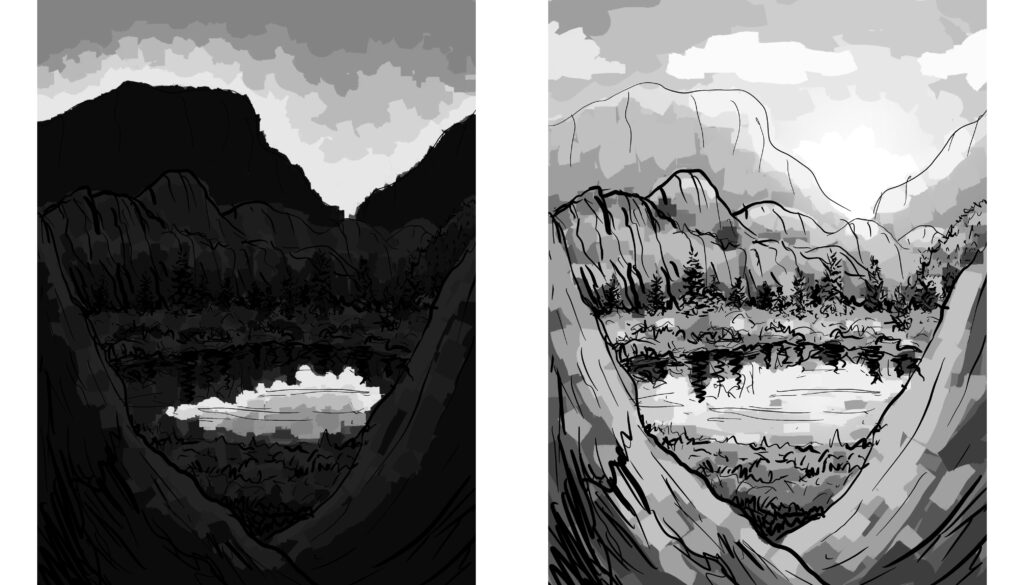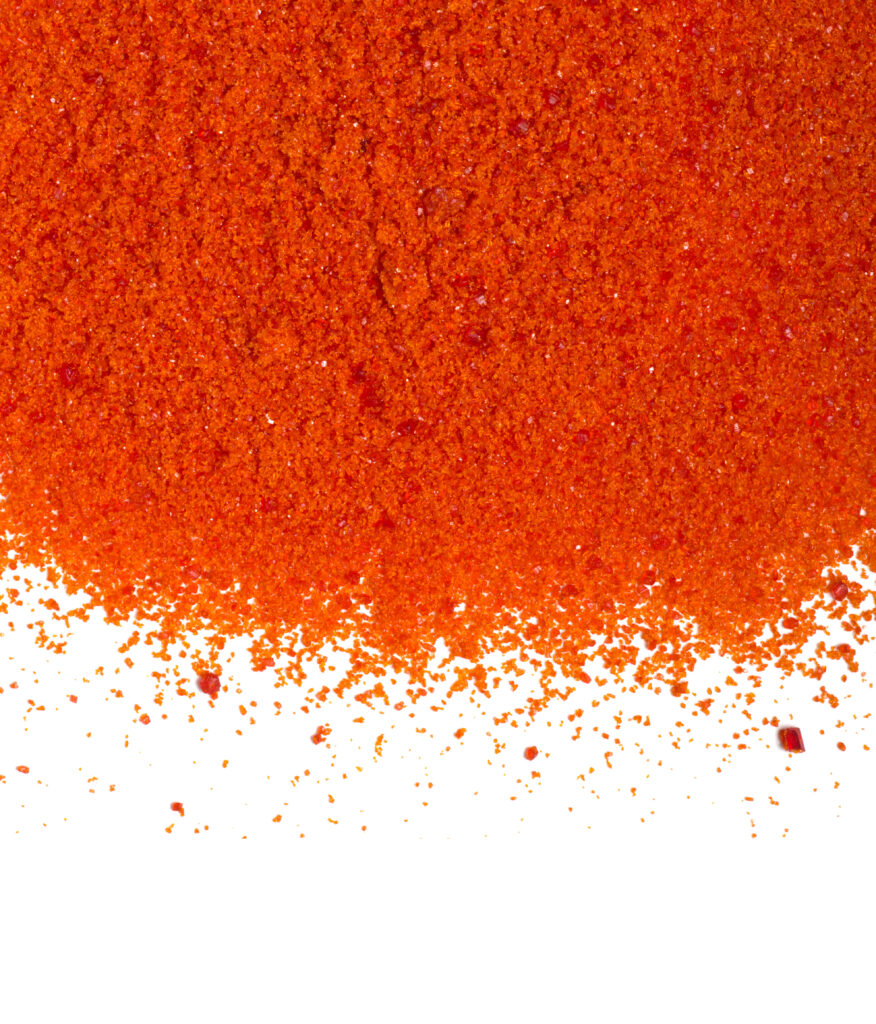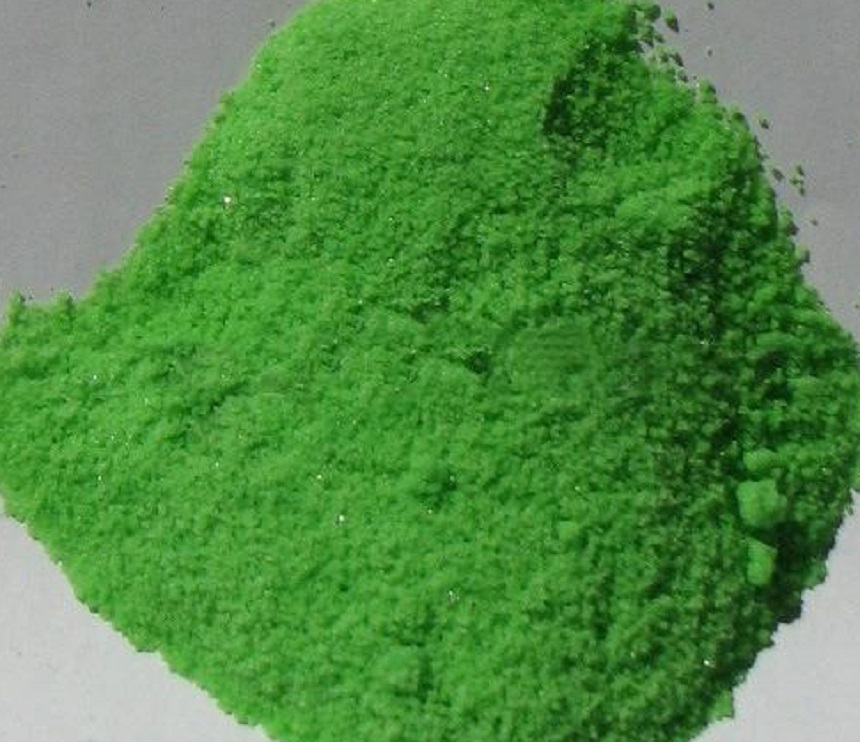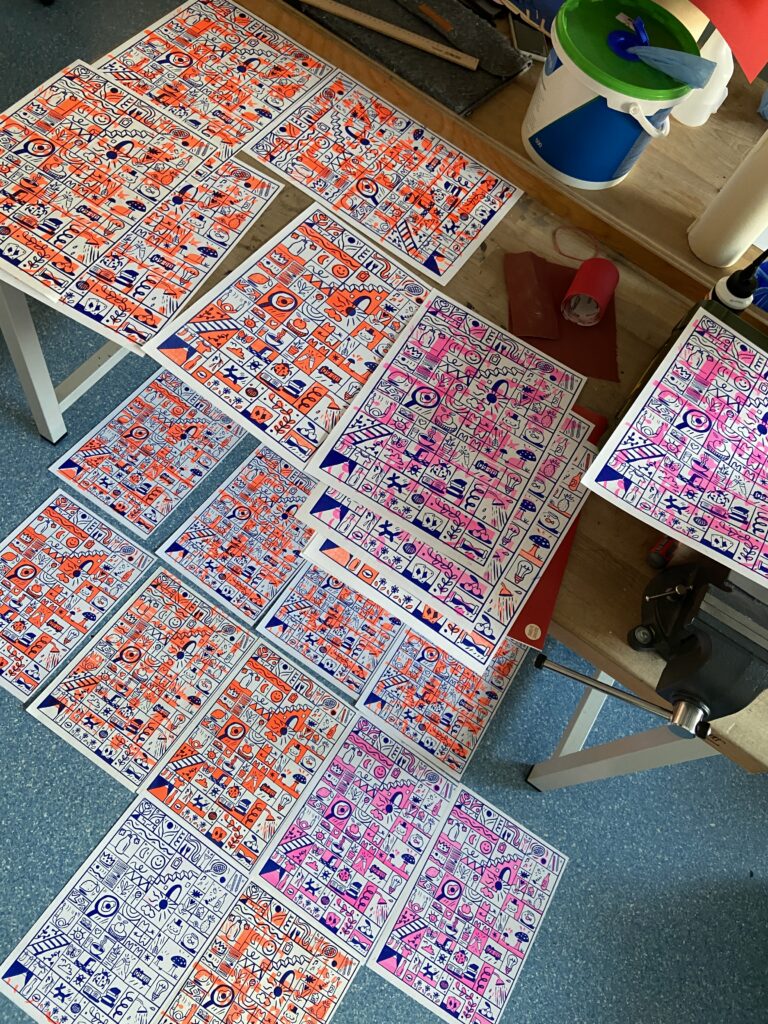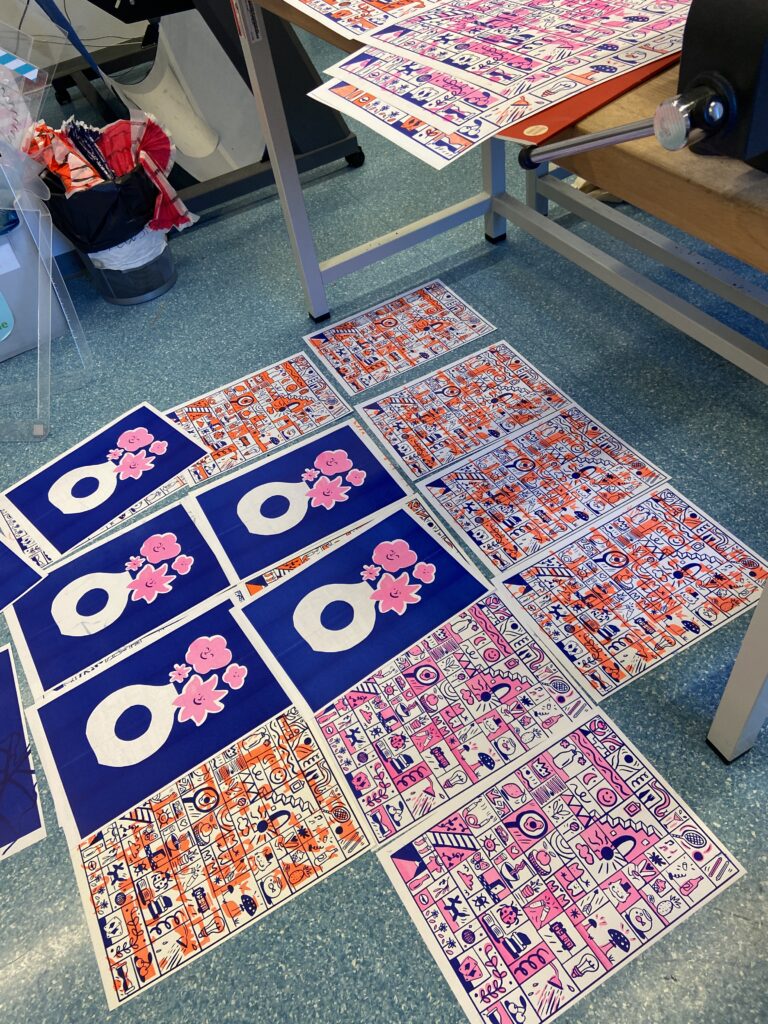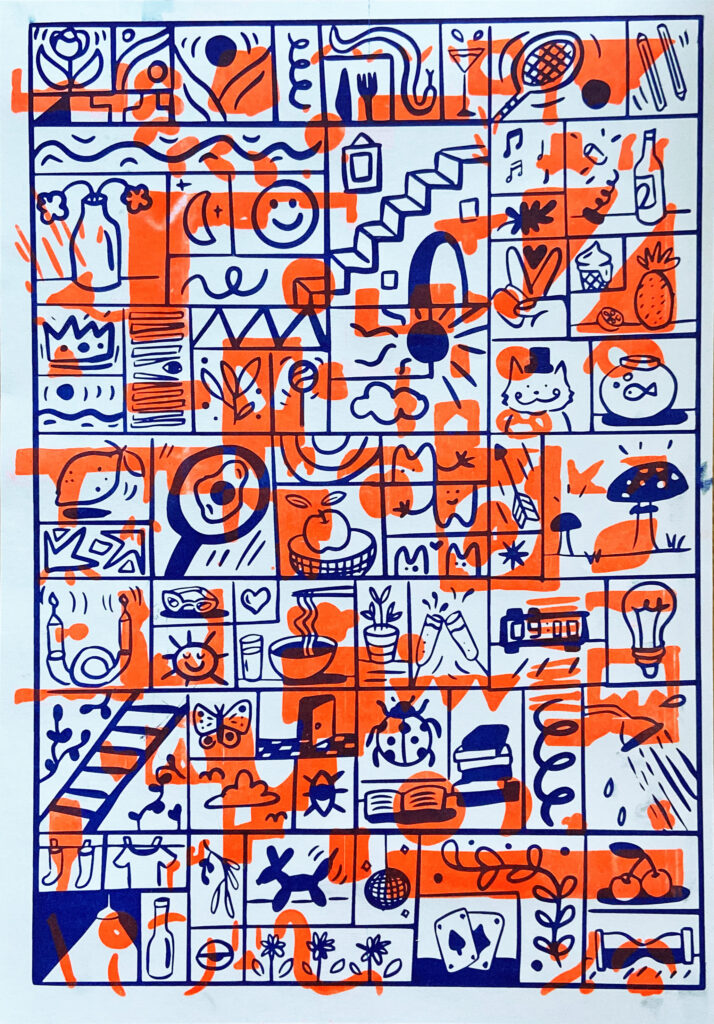– Elena Waschl
As a small insertion I want to post my insights & learnings from OFFF Barcelona 2023!
Wichtigste Notizen zur & von der OFFF Barcelona
23. -25.4.2023
Bureau Borsche:
- Colour system of Bairisches Opern House
- Jedes ahr eine neue Farbe
- Haus der Kunst
Future Trends, by It`s nice that
1.) Maximalist & Messy
– wirf alle Farben zusammen und sei kreativ beim Weg sie zu kombinieren!
– Collage Style = wild & mixed
– allowed to make mistakes!
2.) Returning to Retro (trendy asthetic)
@ Trè Seals, Washington DC
@Zoè Pully, Rhode Island
3.) Sci-fi Optimisma
– creating with art more hopeful future
@Luke Penny, London
4.) Make it More
– MOTION make it MORE!
– allow more meaningful messages!
@Pitch Studios
5.) AI & Machine Learning
– Learn & prepare how we can work TOGETHER!
– AI will never replace emotions!
Creation =NOT= Creativity
Marta Cerdon
Life is not linear!
Schönheit hat auch seine Berechtigung … siehe in der Tierwelt & Natur!
Painting letters is like drawing emotions & expressions!
Mit Motion you can push the level of expression!
Take grids!
Why? Wie bei einem Fußballplatz, das Spiel findet auch im Feld statt und nicht sonst wo!
How?
- Setz dir ein Feld / Definiere deinen „Spielbereich“
- Überlege dir eine Formensprache, eine “Wie fühlt sich das zu Layoutende Projekt an?“ Gib ihm eine Form, reihe sie aneinander, Größe? Häufigkeit?, etc.
- Finde Muster, setzte Verbindungslinien, finde eine Regelmäßigkeit! Erstelle ein Grid
- Tob dich aus und animiere vl.
Lettering:
Überlege dir:
- Welches Material passt zu meinem Projekt?
- Wie könnte ich mit dem Material Buchstaben kreieren?!
- Inflatable…?
- Wie kann ich die AI zur Hilfe nehmen?
- Suche nach Rythmic?
- Gibt es Bereits geschichtliches dazu? Wie wurde damals geschrieben?
- Thin what it look & feel like…?!
- Little by little!
- Get abstract!
Communicate Ideas!
5×5 Rule!
We make our decisions in 5 seconds from 5 meter apart!
(Check out your work time by time under this parameters!)
Alejandro Masferres
Self expression = your identity
We all try to find ourself, and we try to find a role.
Everyone has talents, in our jobs we need / try to fit the roles
How to make people getting ideas?
First, people need to understand themselves, then others.
Five patterns how people behave in a creative team:
1. Understand (Kreis) o
2. Define (Rechteck) []
3. Ideate (offenenes Dreieck) <
4. Filter (geschlossenes Dreieck) >
5. Energise (Stern) *
Important to have a mix of patterns in a creative team!
Every person might be a mixture too.
BUT REMEMBER:
You can be everything with your pattern! A o< can be a doctor but also a waiter!
As long as you do it in our own way!
You can use all patterns in a design process J
“Do it with your mindset not with your role!
A job is a task = you can do it in many ways!
Gemma O’Brian
- Be BOLD
- Be a ReBEL
- Create JOY
Tipp’s
a.) Collect stuff and put it in your own design book
=finde vl. einen “roten Faden”
b.) Caligraphie is a process!
c.) BEGIN YOUR VISUAL DIARY
d.) combine your interests!
e.) explore! In REAL Life (Materials, patterns, by nature etc.)
f.) train yourself & draw from real life!
Sarah Boris
“I think we are all a bit like Schwämme – wir saugen auf was uns gefällt”
Knowing when to quit! Don’t be afraid
1.) It is up to us, where we set our boundaries
– pandemic told us: There is really nothing in world that is that urgent!
2.) We do not need to be named as a special “position”
Artist vs. Designer? You can be everything!
Never let stop you by others!
Kelly Anna
Figure out:
- How to make it happen
- Invest in your relationships!!
If you struggle: Look back and see how you developed so far! J
Larger than life…
we are more capable than we think…
ARE YOU BOLD ENOUGH?!
Never STOP: Exploring & Experimenting!
Road is maybe rough but don’t be shy and go your way
with curiousity and think of a way presenting your work & yourself
From Form
- Forest become our installation area (Vlieland Festival 2016 NE)
- Sometimes you need to look twice
Brachten einen Spiegel und fotografierten ihn und die Umgebung.
Combi of Beauty & Fear
Pentagram
Identity systems, keep on earth & show analog
play with typo & zerlege sie! Finde den kleinst möglichen nenner! Suche nach bestehender Schrift und untersuche diese!
Überlege wie kann die Schrift im Real Life umgesetzt werden? Bring to Life!
>>> Material? Größe, 3D? Komposition, Integration? Ums Eck?, etc.
Build a integrative language!
Building a character! Works on- & offline! Multiple Materials!
Own, flexible, forms, typo, etc.
AUDIO!
Integrate the form in various ways!
– Create maps of whatever of J
– Play with dots, solids, squares, etc.!
Information Visualisieren & longlasting
Brian Collins
Exist to make “wahnwitzige” produkte
cancel: Minimalist, variable products!
MAKE MISTAKES PART OF THE SOLUTION
= gibt der solution ihre Personality!
Eg. Spotify:
- Music can change emotions binnen seconds!
- Colour blocking (break rules!)
- Music is so much more than b/w
Create a world and a fitting dictionary
Create a tone of voice!
Quotes:
(David Carson)
“If you did not get the money, would you do the job”
“Put your work at places where they are not common”
(Framework)
„I am not failed, I just founded 10.000 way which does not work“
“And sometimes you find what you are not looking for”
(Gemma O’Brian)
“You can be everything!”
“Art is when no one is telling you what to do!”
“Dream baby, dream”
“collect all (weird) words & phrases!
(Sarah Boris)
“I don’t take NO as an answer!”
“There is more in life, than increasing its speed”
“Do not always ask for permittion”
“It is personal freedom to define yourself”
(Kelly Anna)
“Look up and focus”
“she stole the show”
“Run past the future”
“The game has changed”
“Fuck it, I am doing it anyway”
(From Form)
“into the great wide open”
(Elizabeth Alexander)
“What are the stories we have not heared?”
(Brian Collins)
“the best ideas comes from being open & doing the opposite way we expect to do so”
“change the way you are looking at things”
“Change doesn’t happens overnight, until it does”
“Design is what we make possible!”
(Antoni Gaudì)
“if you want to be original, you need to get back to origin” / “Originality consists in returning to the origin”
“Glory is light, light gives us joy and joy is happiness of the spirit”
“To to things right, first you need love, then technique”
